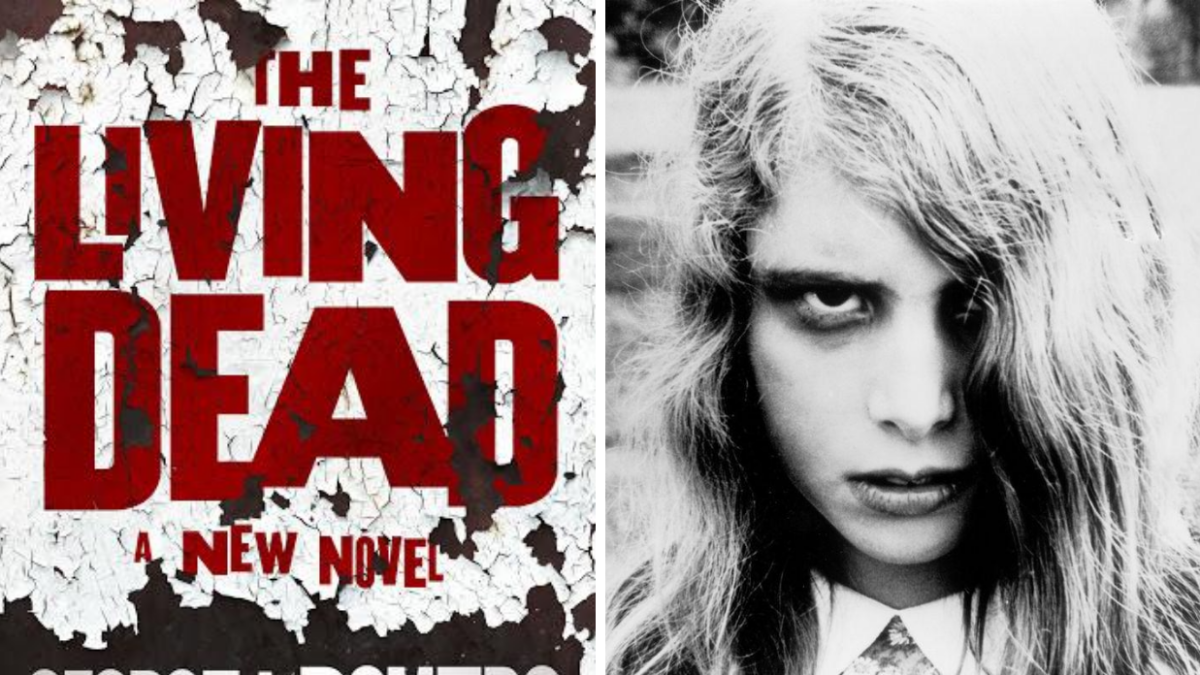How The Living Dead Completes Romero’s Zombie Legacy
Zombies gain their souls at the expense of humanity in George A. Romero and Daniel Kraus' novel The Living Dead.

This post is sponsored by 
George A. Romero figuratively wrote the book on zombies with his low-budget, independent 1968 horror film epoch Night of the Living Dead. World War Z, 28 Days Later, Zombieland and even The Walking Dead trudged that territory but didn’t map much new terrain. Romero’s final novel, The Living Dead, completed by author Daniel Kraus (The Shape of Water novelization), doesn’t challenge so much as deepen the zombie trope Romero filled out with his subsequent works on animated corpses, when The Living Dead had their Day, Dawn, Land, Diary and Survival. But, with it, Romero and Kraus do peer deeper into the mirror to find a bitter reflection of the horrors Romero brings out in The Living.
The Living Dead is character-driven in ways the feature films could never be. In Night of the Living Dead, the audience didn’t know, nor would they have cared, whether Helen Cooper (Marilyn Eastman) put on weight after marrying Harry (Karl Hardman). But we know this about Rosa, the wife of novel protagonist Luis Accocola, the Assistant Medical Examiner who logs the first case of reanimation in The Living Dead. We also know Luis paid for Rosa’s education and had to wait to marry her because she was so much younger than him. We know Rosa suffered a miscarriage long before the recently deceased became the ambulatory diseased.
We’ll never know if “They’re Coming to Get You” Barbra (Judith O’Dea) ever dreamed of dancing with Fred Astaire at night. But we know Luis’s assistant Charlene Rutkowski recoils from the very sight of Astaire when her mother Mae tunes in to the classic movie channel because the top hatted, tuxedo-sporting tap dancer tries to lead in her nightmares. Even before John Doe becomes the archive in the novel’s version of Patient Zero, Luis wants to know more about his history, whether he mattered. Why the homeless man is dressed so fine, and why he doesn’t have the curved spine of the long-term vagrant. In this respect, he is Romero. The unimportant details may not solve zombification, but it holds clues to the fading humanity.
The Living Dead is a fitting end to Romero’s zombie chronicles. The novel form allows him to bring more of himself into the pages, each of the characters filled out with flavors Romero himself test-tasted. There is also a bittersweet meta irony to the fact that the horror genius died before finishing the work and it was reanimated by Kraus, an unabashed fan and likely successor to the “Father of the Modern Zombie Film.” He hides Romero “Easter eggs” throughout the book, while also bringing in references to the pandemic apocalypse novel The Stand. Romero worked frequently with Stephen King, adapting his writer’s nightmare The Dark Half, having a barrel of fun with Monkey Shines, and indulging their shared love of EC Comics with Creepshow. The feature film adaptation was even shot in the four color scheme which defined the magazine. They further explored the horrors of publishing with Bruiser. The city of Bangor, Maine, which is King’s home turf, is referenced within the first few pages. He and Romero are wonderfully horrific friends.
The Living Dead is divided into three acts. Act One tells the story through the introduction of disconnected characters. It unfolds like an archive from the future written from multiple points of view. The history is being put together by a team in Washington, led by the researcher Etta Hoffmann. She is autistic and unflappably records survivors’ stories. Goaded on by an internet troll named Chucksux69, News anchor Chuck Corso at the cable station WNN broadcasts the events as they come in, even though he has no idea if anyone can see him. He does this while his co-workers try to eat him. Similar things happen at sea, where the US Navy aircraft carrier Olympia becomes a floating arena where dead sailors face off against the living crew. The gospel of the dead is spread zealously by a preacher in the book.
“When there’s no more room in hell, the dead will walk the earth,” Romero warned in Dawn of the Dead. The characters in The Living Dead have to learn this for themselves. The only problem with living in a world written by George A. Romero is that the inhabitants didn’t grow up in a world with Romero in it. They don’t know what to do when the dead won’t stay dead. One of the most consistent things about zombies, whether they’re found in the Living Dead universe or one of the many other genre works, is you kill them by shooting them in the head. It doesn’t have to be a gunshot; Daryl on The Walking Dead does the deed with a bow and some arrows (though that series has gone on for a full decade without ever using the word zombie). From the very first ambulatory corpse, played by Bill Hinzman in Night of the Living Dead, to the present, a fractured skull is the only way to stop chomping teeth. Try telling that to the people in the book.
Why do zombies keep on biting? Day of the Dead posited the corpses reanimate because of primitive impulses in the spinal column. We, the audience, know from that movie onward it was because of special effects wizard Tom Savini. It would be nice to think of his hand on the elderly zombie in the novel who tries to gum someone to death. In The Living Dead, we learn zombies just wake up hungry. “This hunger is different from any you knew before,” a chapter opens. “This hunger is a lack. Something has been taken from you. You do not know what. This hunger is everywhere. Hunger, the fist. Hunger, the bones. Hunger, the flesh. Hunger, the brain.” Zombies aren’t evil, they are animalistic. Humans, on the other hand, are free to act horribly. If this particular horror niche is dead it can be reanimated here with this book. Night of the Living Dead brought the genre to life. The Living Dead gives Zombies souls.
When Romero and some friends shot the indie film for just over $100,000 that would become The Night of the Living Dead, the country was going to hell. The Vietnam War was bringing death to the dinner table daily on the evening news. The generation which grew up in the shadow of the nuclear bomb was pulling away from a rotting society, unraveling like an exposed lower intestine. While women sew American flags sometime between “Year Fucking Six” and “Year Fucking Seven” of The Living Dead, Johnny and Barbara walk past a shredded flag as they enter the cemetery where their father is buried at the start of the film that started it all. The wreath is an empty gesture. Johnny can’t even remember what their father looked like.
Inspired by Richard Matheson’s 1954 novel I Am Legend and its film adaptation The Last Man on Earth, starring Vincent Price, Night of the Living Dead reincarnated Zombie movies. Once the realm of island magic culturally appropriated by actors like Bela Lugosi and George Zucco, zombies were now hungry legions munching on the living. Brains were not yet the delicacy The Simpsons would make them out to be. The undead are a metaphor for whatever we want to put on them. Romero is a political artist and the book is contemporary. Like the ill-equipped national response to COVID-19, we watch an unprepared society face a cataclysmic event and come apart at the seams. Similar to the effects of the quarantine, the zombie apocalypse is good for the environment. Also mirroring our times, the zombies infest a hate-filled world though they prove to be an equalizer of all classes and in the toxic racial divide.
“Someone dies, someone else learns to live,” Greer, a Black teenager who escapes an overridden trailer park in the Midwest at the beginning of the novel, is taught. Minority characters feature prominently in The Living Dead. Reverend Martin Luther King Jr. was assassinated the year Night of the Living Dead was released. In the film, Ben, a Black character played by Duane Jones, survives the undead campaign, the tribal maneuvering of the other captive combatants around him, casual bigotry and betrayal only to be shot in the head by passing zombie thrill-killers. The final moments of the film shows photographs of men with dead zombies which look eerily similar to lynch mob photos.
Romero didn’t only use the undead as a political metaphor. They are endemic to all society. The Zombies aren’t the only brain-dead or dying characters in his films or the novel. In The Living Dead, most of the people’s minds are already infested by paranoid distrust of the news media and the hatred encouraged by social media. Luis’s life is saved at one point because he’s not flipping through his cell phone as he usually does. He actually notices the looks on the people’s faces. In Romero’s 1978 installment Dawn of the Dead, the citizenry’s minds were numbed by TV, radio and consumerism. Its biggest scene happens in a Pittsburgh shopping mall with muzak playing in the background.
Act Two summarizes what would be the territory of 1985’s Day of the Dead (which gave zombies class-consciousness), 2005’s Land of the Dead, and Romero’s “found footage” installment Diary of the Dead (2007), but takes a turn at 2009’s western Survival of the Dead. Subtitled “The Life of Death,” Act Two spans eleven years, all of which are being recorded in “The Hoffmann Archive of Tales from the New World.” We learn zombies are more like us than we might wish to believe. Like modern man wastes most of its animal-based consumer products, the zombies only eat five percent of their kill. They also hold grudges. Zombies outnumber humans 400,000 to one. Camels, lions and zebras are immune to reanimation, but chimps come back from the dead.
Straightforward as they may be, Romero’s films were rarely what they seemed through the action. Subversive social commentary runs through his 1978 vampire film Martin, which was more about unfettered schizophrenia than vampires. John Amplas played the title role in a very realistic, and very violent, exploration. He drugs and rapes his victims before drinking their blood. The Crazies (1973) was more about the society struck by a military biological weapon more than an epidemic containment film. The Living Dead is more than a zombie novel. It is a bitter parable.
Act Three moves 15 years after the apocalypse as survivors try to put together a new civilization amidst an evolving zombie population. It is a planetary reset. The museums are covered in graffiti and overgrown. People begin to read books, mix paint, shoot each other in the face when agitated. The dead win.
George A. Romero died on July 16, 2017, a relatively innocent time which, although it was only three years ago, seems very far away. Donald Trump rode a racist wave of xenophobia to the whitest White House the country has seen since President Andrew Jackson, but he was still treated as a joke. The Living Dead was written before COVID-19, the killing of George Floyd and a police force which militarized against protestors faster than the zombies could run in 28 Days Later. Romero and Daniel Kraus are visionaries who were able to make a parable of today’s times in almost real time. The news on Max Headroom came at you from 30 minutes in the future. The future legend of The Living Dead was predicted only months in advance to be delivered exactly on time.
The Living Dead will be available to buy and read on August 4th. It is now available for pre-order.
